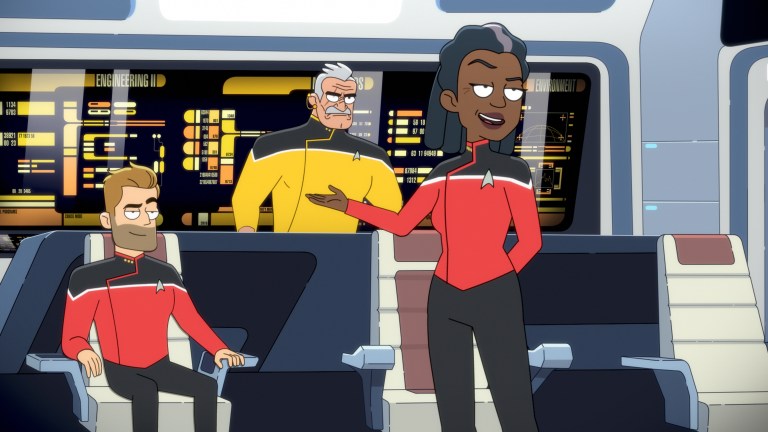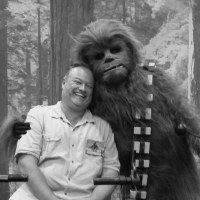Inside Star Trek: Lower Decks’ Deep Space Nine Revival
While Deep Space Nine has been an influence on Star Trek: Lower Decks all season long, this episode truly brings DS9 back to life.

This article contains Star Trek: Lower Decks spoilers.
Star Trek: Lower Decks Season 3 Episode 6
Star Trek: Lower Decks episode 6 is an unabashed love letter to another classic Trek series. In fact, every call back moment in this episode is designed to fill the audience with an overwhelming wave of nostalgia for Star Trek: Deep Space Nine. The reasons? Characters, cultures, religions – Deep Space Nine is the Trek series that arguably has the richest, most recognizable lore in the franchise. That certainly comes out in this week’s episode as we delve into why it seems more like a DS9 episode rather than a Lower Decks one.
RULES OF ACQUISITION
Even the title of the episode, “Hear All, Trust Nothing” is a callback to some of the lore that made DS9 a standout in Trek history.
“Since Quark was such a big part of the episode, and because we wanted this episode to make a lot of profit, we had to go with a Rule Of Acquisition for the title,” Star Trek: Lower Decks showrunner Mike McMahan jokes to us.
But of course, if you’re going to quote a Ferengi maxim, that can only mean someone familiar is close behind…
THE RETURN OF QUARK
When Ensign Boimler’s new “Bold Boimler” personality manifests itself at Quark’s Dabo tables, there’s a chance to not only meet another familiar character, but to also compare lung capacities.
“I mean, Jack Quaid can scream, but Armin Shimerman can scream like nobody else in the world,” McMahan says. “I loved working with Armin Shimerman.”
As for Shimerman, he told us of his time with the crew of the USS Cerritos.
“I loved working with Lower Decks,” Shimerman says. “Returning to play Quark was as easy and comfortable as slipping into a favorite bathrobe, warm and familiar. Of course, I had to brush my teeth!”
BRINGING DS9 TO LIFE IN ANIMATION
The tone had to feel like Deep Space Nine as well, and moments that show the Lower Deckers walking the Promenade, passing by the storefronts and familiar scenery all help set the scene. Moments like Rutherford wanting to chat with a familiar junior reporter, or the crew seeing some other well-known faces at Quark’s bar, and hearing shouts of “Dabo!” all help, too.
Even the extended time the Cerritos takes to orbit the station mirrors the grandiose opening sequence of Deep Space Nine that gives the audience a view of the majestic pylons with the theme resonating in the background and steals it for its own. Why? To remind them of the wonder of this station, positioned closely to a stellar phenomenon of such power like the wormhole to the Gamma Quadrant.
There’s a pause while Commander Ransom orders the helmsman to take it around one more time to make it seem like “we’re in awe of the pylons,” helps remind the audience that we’re in a Lower Decks episode after all.
“I really wanted to make a Deep Space Nine episode,” McMahan says. “It had to have a Deep Space Nine flavor. I’m a huge fan of Deep Space Nine, and I’m a huge fan of Quark and Kira. But at the same time, it had to also be a good Lower Decks episode.”
THE ORION/WORF CONNECTION
“What I liked about this story was that every Lower Decker has something going on – but I really liked Tendi’s story,” he says. “We wanted to make Orion culture less mono-cultural and this was a chance for Tendi to run into an Orion (Messk) who didn’t even grow up on Orion but who wanted to appear to be Orion. Obviously, this is a huge callback to Worf for me, as he obviously didn’t grow up on Kronos, [but it]was really important to him to fulfill all these cultural obligations he had as a Klingon. It’s a little bit of a reverse of that. Because she has those values but the guy she meets doesn’t know anything.”
KIRA
The apparent past history in the Bajoran Resistance between Kira and Shaxs not only gives the audience a sense of a new backstory between these two characters but it also is a huge callback to the Cardassian Occupation. Shaxs, seeing the station’s pylons goes one step further and can’t help but express the Bajoran hatred of everything Cardassian by mocking the architecture.
Seeing objects like raktajino mugs in different shots, Cardassian computer consoles in the background, and watching the Lower Deckers interact with all these places and characters makes us recall what a thoroughly different series DS9 was from Star Trek: the Next Generation.
“I really loved spending time there; utilizing these characters like the Gamma Quadrant aliens that we had met before – keeping it so it didn’t change anything,” McMahan says. “It was just like finding one extra little stocking stuffer at the end of Christmas.”
In the end, we don’t just remember what an impactful influence Deep Space Nine had on Trek fans and the franchise, but through the humor of Lower Decks, we see its richness and contributions to Star Trek lore and we also remember the fun we had while we, like its crew, were stationed there for a short time.
